Q&A – Ask Neil: August 10, 2023
(Please read these instructions carefully.)
Before you post your question, please look at recent issues to see if someone else has already asked it. You might find your answer there.
How to submit your question…
(Note: You may need to allow a pop-up window to come up in order to get the link for sending your photo(s). If you have already submitted your question and didn’t see the pop-up window, please click here.)
- Click the link provided below to post your question. After you submit your question, a new window will pop up giving you the address to which you can e-mail a SHARP, HIGH-RESOLUTION PHOTO to accompany your question. Please DO NOT SEND THUMBNAIL PHOTOS in case I need to zoom in to see things.
- Click here to post your question.
- Please ONLY POST YOUR QUESTION ONE TIME. We can only accept a set number of questions each week, and when we get duplicates it costs other people their chances.
- One question per reader, please.
- Please use this only for posting questions – not for standard emails.
- Watch for your answer in the following week’s e-gardens.
- I choose those of greatest general interest. For example, plant IDs seldom make the cut.
- I must have your first name or initials.
- I must have your city or county. (Texas is a very large state.)
QUESTION 1
HOW DO WE COPE WITH VITEX SPROUTS WHEN WE PLANT A NEW TREE?
Question: We recently had to cut down our large tree-form vitex, and the stump is regrowing aggressively. We want to plant a small ornamental tree this fall, perhaps a redbud, rusty blackhaw viburnum, single-trunk crape myrtle or saucer magnolia, but we don’t want vitex shoots coming up everywhere. What can we do? We don’t want to poison the soil. The photo is just 14 days after the cut. Candace G., Irving.
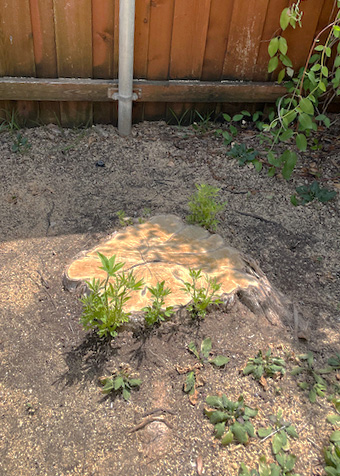
Answer: You need to get the old roots out of there. It would have been easier if you had left 12-15 in. of the trunk so you could hook a heavy chain around it and pull it out when the ground was soft. (You would probably have had to cut the larger lateral roots first, however. It probably would have meant taking down one section of fencing temporarily so you could pull from the alley.)
At this point the easiest thing to do would be to hire an arborist with a stump grinding machine to remove it for you. Otherwise, you’ll need to dig it out by hand with a sharpshooter spade and a long-handled axe and a pruning saw. Don’t let your chain saw dip into the soil. Soil dulls a chain saw instantly. You may still have to figure a way to wrap a heavy chain around the roots and stump and pull the stump using a very low gear.
Now that I’ve scared you sufficiently, there might be an easier way out of this issue. You could also drill finger-sized holes into the old stump. Blow out the sawdust and fill the fresh holes with a broadleafed weedkiller (containing 2,4-D). It would soak through the wood and down through the roots. If you were careful not to split the sides of the stump it would not go into the soil. You could refill the holes a week later just to get an ample amount into the stump. Then plant your new tree several feet farther into the yard and let this one die and decay.
You didn’t ask for any opinions on the trees you mentioned, so please forgive me. Saucer magnolia would really need to have shade from late morning on in Irving. It and rusty blackhaw viburnums are really shrubs (as was your vitex in all probability), so you’ll have a hard time looking at them as trees. And I’m not a huge fan of single-trunk crape myrtles. As much as I love the plants in general, single-trunk specimens are too much of a risk. They can become top heavy and lose their symmetry. Or, if anything happens to the one trunk and it is broken, it’s difficult to retrain the tree back to one trunk. I’d go with a 3- or 5-trunk specimen of one of the large varieties. Don’t overlook Teddy Bear or Little Gem dwarf southern magnolias.
QUESTION 2
HOW CAN I COMPARE NITROGEN IN TWO BAGS OF FERTILIZER?
Question: What is the difference in a bag of fertilizer with the nitrogen # of 16 as opposed to a bag with the nitrogen # of 32? John V., Grapevine.
Answer: I left your question absolutely unedited so I could use your symbols. You are mixing two terms. When you are seeing “16” or “32” as parts of the three-number triad on a fertilizer bag, they are making up the products’ analyses. They are referring to the percentage of nitrogen in the bag and not to the total number of pounds of nitrogen in the container.
Let’s just say that you had equal weight 30-pound bags of 16-4-8 and 32-8-16. All those numbers refer to the total percentages of nitrogen, phosphorus and potassium respectively.
The 16-4-8 bag would have 16 percent X 30 pounds, or 4.8 pounds of nitrogen. It would also have 4 percent X 30 pounds, or 1.2 pounds of phosphorus and 8 percent X 30 pounds, or 2.4 pounds of potassium in the bag.
The same thing goes for the 32-8-16 bag. It would be double in its contents. 32 percent X 30 pounds, or 9.6 pounds of nitrogen, 2.4 pounds of phosphorus and 4.8 pounds of potassium.
There are other factors that determine which fertilizer would prove to be better for your needs, in fact, which will be the better bargain. Part of it has to do with the form of nitrogen. You want 30 to 40 percent of that to be in encapsulated or coated, slow-release form.
However, in very general terms, you might expect to pay twice as much for the fertilizer with 32 percent nitrogen compared to one with 16 percent, all other things being equal.
For the record, most soil test results that come back from Texas landscapes and gardens suggest that we not apply any phosphorus (middle number) to our Texas soils at all. It’s very slowly soluble, so it accumulates in the soil, often to harmful levels.
QUESTION 3
WHAT IS KILLING MY FRUIT TREES?
Question: Is this fire blight, cotton root rot or something else? I have an orchard with about 10 peach, plum, apple, pear and fig trees. Recently one of the apple trees turned brown, then died. Now the pear trees’ leaves are turning brown. Bobby K., Hays County.
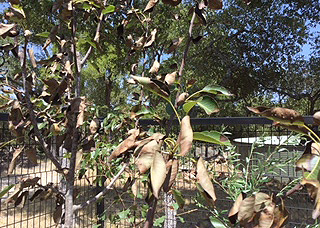
Answer: I’m pretty sure this is fire blight. Please see my Answer 3 from two weeks ago for even more information. It’s a bacterial infection that is found only in the Rose Family, especially on pears and apples. I’m never seen it bother peaches and plums. Cotton root rot, by comparison, gets all of them. As you’ll see in the information I provided to that reader, a lot of fire blight’s impact depends on the variety of pear tree that you have selected. You didn’t mention which varieties you have. Some are much more vulnerable than others. Types recommended by Texas A&M are best suited to local areas.
QUESTION 4
WILL OUR MEYER LEMON BEAR FRUIT AGAIN?
Question: We have a Meyer lemon, planted last fall into a large pot on our west-facing deck. It froze despite being wrapped. I waited until spring and trimmed the dead branches. It has come back, but it has two very long branches. Will it bear fruit? What should we do? Neil P., Austin.
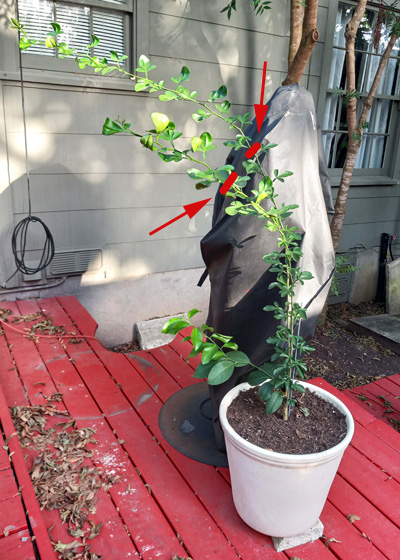
Answer: Trace each stem back to where it originates on the main stem that froze. Hopefully they have sprouted out above the graft union, which would mean that they are the true Meyer lemon. Otherwise, they are of another type of citrus, perhaps trifoliate orange (thorny and very bitter, seedy fruit).
Your plant looks like it needs more uniform lighting. Turn it so that it will receive sunlight from all directions. I would also prune each branch back significantly to encourage more lateral growth. I’ve tried to mark your photo to show where I would make the cuts. It will need a much larger pot as it grows, and you will need to bring it indoors any time temperatures drop to, or below freezing.
QUESTION 5
WHAT IS THIS ON MY GUAVA PLANT? NEEM OIL DIDN’T SEEM TO HELP IT.
Question: What is this white insect on my guava plant? I used Neem oil on it, but they came back within a few weeks. T.N., Parker, Collin County.
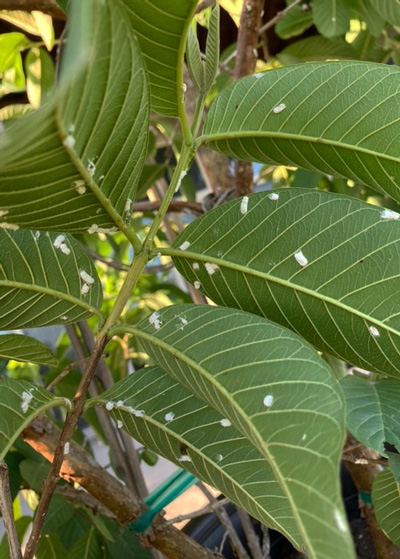
Answer: I began by searching “scale insects guava.” That took mere moments and I found several good leads from both the University of Florida (scroll down on https://edis.ifas.ufl.edu/publication/ig072) and the government of Hawaii (https://hdoa.hawaii.gov/pi/files/2018/03/Papaya-Scales-3-2018.pdf). Granted, this second citation mentions it’s afflicting papayas, but that it also is found on guavas.
This publication from the University of Florida says that horticultural oils are perhaps the best controls if applied while the scales are young, and that soil-applied systemic insecticides such as Imidicloprid are effective as well.
QUESTION 6
WE HAVE REPLACED JAPANESE YEWS THREE TIMES. WHAT WOULD DO BETTER HERE?
Question: We have been trying to use Japanese yews at the corners of our house. We’ve replaced one three times, and two have not done well. They froze in February 2021. We would like something that would grow to 6 to 10 ft. tall. Suggestions? Ray J., Sugar Land.
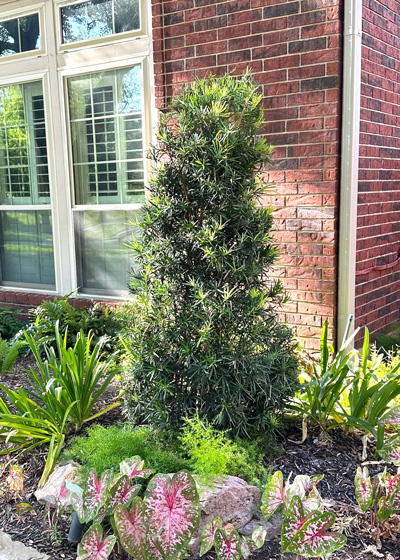
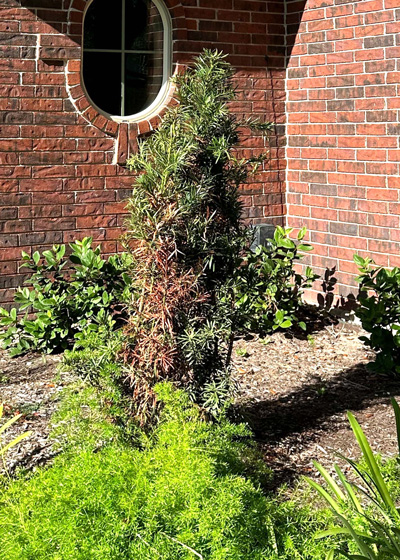
Answer: I just planted an Oakland holly in that same type of setting at our house. It will grow to 10 ft. tall and 3-4 ft. wide and will give you rich evergreen foliage. It’s great in sun or shade, and it’s winter hardy all across Texas. It does well in all of our Texas soils.
